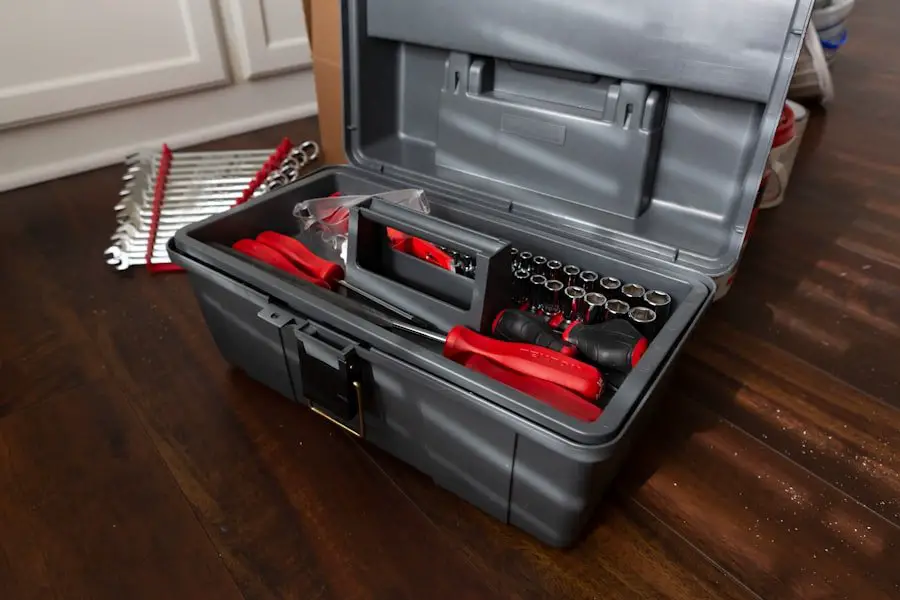Spark plug replacement is a critical aspect of engine maintenance, essential for optimal performance and efficiency. These components are integral to the combustion process, igniting the air-fuel mixture within the engine’s cylinders. As spark plugs deteriorate over time, they can cause various issues, including reduced engine performance, misfires, and decreased fuel economy.
Regular inspection and replacement of spark plugs are therefore crucial elements of vehicle upkeep. While some may find the task intimidating, changing spark plugs is generally a straightforward and economical procedure that contributes significantly to a vehicle’s smooth operation. This guide provides a detailed, step-by-step approach to spark plug replacement, including safety measures, required tools, helpful tips, and common pitfalls to avoid.
Key Takeaways
- Changing spark plugs is an important part of regular vehicle maintenance to ensure optimal engine performance and fuel efficiency.
- Safety precautions such as wearing gloves and disconnecting the battery are essential when changing spark plugs to prevent accidents and injuries.
- Necessary tools for changing spark plugs include a ratchet, spark plug socket, extension, and a gap tool for adjusting the spark plug gap.
- A step-by-step guide to changing spark plugs involves locating the spark plugs, removing the ignition coils, removing the old spark plugs, gapping the new spark plugs, and reinstalling the ignition coils.
- Tips and tricks for a successful spark plug replacement include applying anti-seize lubricant to the threads, using a torque wrench for proper tightening, and checking for any engine misfires after installation.
- Common mistakes to avoid when changing spark plugs include over-tightening the spark plugs, using the wrong spark plug for the vehicle, and not properly seating the ignition coils.
- In conclusion, it is important to double-check the installation of the spark plugs, reconnect the battery, and start the engine to ensure everything is working properly after changing spark plugs.
Safety Precautions and Gear
Safety Precautions Before Starting
It is crucial to prioritize safety before attempting to change spark plugs. Always ensure that the engine is cool, as working on a hot engine can lead to burns and other injuries. Additionally, disconnect the vehicle’s battery to prevent any electrical mishaps while working on the ignition system.
Protective Gear and Workspace
When working under the hood, wear protective gear such as gloves and safety glasses to protect yourself from potential cuts, burns, and debris. It is also advisable to work in a well-ventilated area to avoid inhaling harmful fumes or exhaust gases.
Referencing the Owner’s Manual
Lastly, always refer to the vehicle’s owner’s manual for specific instructions and safety precautions related to changing spark plugs for your particular make and model.
Necessary Tools for Changing Spark Plugs

Before getting started, gather all the necessary tools and materials for changing spark plugs. The following tools are typically required for this task:
– Ratchet and socket set: A ratchet and socket set will be used to remove the spark plugs from the engine.
– Spark plug socket: A specialized spark plug socket is designed to securely grip the spark plug for removal and installation.
– Spark plug gap tool: This tool is used to ensure that the spark plugs are properly gapped before installation.
– Torque wrench: A torque wrench is essential for tightening the spark plugs to the manufacturer’s specifications, preventing over-tightening or under-tightening.
– Anti-seize lubricant: Applying anti-seize lubricant to the threads of the new spark plugs will make future removal easier and prevent seizing.
– Dielectric grease: Dielectric grease should be applied to the inside of the spark plug boots to prevent moisture and corrosion.
– New spark plugs: Be sure to purchase the correct type of spark plugs recommended for your vehicle’s make and model.
Step-by-Step Guide to Changing Spark Plugs
| Step | Description |
|---|---|
| 1 | Gather necessary tools and materials |
| 2 | Locate the spark plugs in the engine |
| 3 | Remove the spark plug wires or coils |
| 4 | Use a spark plug socket and ratchet to remove the old spark plugs |
| 5 | Check the gap on the new spark plugs |
| 6 | Install the new spark plugs and tighten them |
| 7 | Reattach the spark plug wires or coils |
| 8 | Start the engine and check for proper operation |
Now that you have gathered all the necessary tools and materials, it’s time to walk through the step-by-step process of changing spark plugs:
1. Begin by locating the spark plugs on your engine. They are typically found at the top of the engine, connected to thick rubber wires known as spark plug wires or ignition coils.
2.
Carefully remove the spark plug wire or ignition coil from the top of the spark plug by firmly grasping the boot and twisting it before pulling it off.
3. Use a ratchet and spark plug socket to loosen and remove the old spark plug from the engine. Be cautious not to damage the threads or ceramic insulator during removal.
4.
Inspect the old spark plug for signs of wear, such as fouling, corrosion, or excessive carbon buildup. This can indicate potential issues with your engine’s performance.
5. Use a spark plug gap tool to check the gap of the new spark plug.
Adjust the gap as needed to match the manufacturer’s specifications.
6. Apply a small amount of anti-seize lubricant to the threads of the new spark plug before carefully threading it into the engine by hand. Use a torque wrench to tighten the spark plug to the manufacturer’s recommended torque setting.
7.
If your vehicle uses spark plug wires, apply a thin layer of dielectric grease to the inside of the spark plug boot before reattaching it to the new spark plug.
8. Repeat this process for each spark plug, ensuring that each one is properly installed and torqued to specification.
9. Once all new spark plugs are installed, reattach the spark plug wires or ignition coils in their respective positions.
10.
Finally, reconnect the vehicle’s battery and start the engine to ensure that it runs smoothly with the new spark plugs.
Tips and Tricks for a Successful Spark Plug Replacement
When changing spark plugs, there are several tips and tricks that can help ensure a successful replacement:
– Always refer to the vehicle’s owner’s manual for specific instructions and torque specifications related to changing spark plugs for your particular make and model.
– Use a piece of rubber hose or a spark plug boot puller tool to help remove stubborn spark plug wires without damaging them.
– Apply a small amount of dielectric grease to the inside of each spark plug boot before reattaching them to prevent moisture and corrosion.
– Consider upgrading to performance or long-life spark plugs if you want to extend the maintenance interval between replacements.
– Keep track of when you last changed your spark plugs and set a reminder for future replacements based on your vehicle’s recommended maintenance schedule.
Common Mistakes to Avoid When Changing Spark Plugs

Avoiding Spark Plug Damage
Over-tightening or under-tightening spark plugs can lead to damage or improper seating, causing potential engine issues. Always use a torque wrench to tighten spark plugs to the manufacturer’s specifications.
Proper Spark Plug Gapping
Failing to properly gap new spark plugs before installation can lead to poor engine performance or misfires. Use a spark plug gap tool to ensure that each new spark plug is properly gapped.
Avoiding Ignition System Confusion
Mixing up the firing order of spark plug wires or ignition coils can cause your engine to run poorly or not at all. Take note of the order in which you remove and reinstall each wire or coil to avoid confusion. Additionally, neglecting to disconnect the vehicle’s battery before working on the ignition system can lead to electrical mishaps or injury. Always disconnect the battery before changing spark plugs.
Conclusion and Final Checks
In conclusion, changing spark plugs is an important aspect of maintaining a healthy and efficient engine. By following this comprehensive guide, you can confidently tackle this task with ease while prioritizing safety and precision. Remember to gather all necessary tools and materials, follow safety precautions, refer to your vehicle’s owner’s manual for specific instructions, and utilize tips and tricks for a successful replacement.
Additionally, be mindful of common mistakes to avoid when changing spark plugs in order to prevent potential issues with your engine’s performance. Once you have completed the replacement process, take your vehicle for a test drive and listen for any abnormal engine noises or misfires. If everything sounds and feels normal, you can rest assured that your new spark plugs are contributing to a healthy and efficient engine performance.
If you’re looking to change your spark plugs, you’ll need the right tools for the job. One helpful article on Just Tidings discusses the importance of having the right tools and equipment for this task. Check out the article here for some helpful tips and recommendations on the tools you’ll need to successfully change your spark plugs.
FAQs
What tools do I need to change spark plugs?
To change spark plugs, you will need a ratchet, spark plug socket, extension bar, gap gauge, and a torque wrench.
Why do I need a ratchet and spark plug socket?
A ratchet and spark plug socket are necessary to remove and install the spark plugs from the engine. The spark plug socket is designed specifically to fit over the spark plug and allow for easy removal and installation.
What is the purpose of an extension bar?
An extension bar is used to provide extra reach and leverage when accessing hard-to-reach spark plugs. It attaches to the ratchet and allows you to reach spark plugs located deep within the engine.
Why do I need a gap gauge?
A gap gauge is used to ensure that the spark plug gaps are set to the correct distance. This is important for proper ignition and engine performance.
What is the purpose of a torque wrench?
A torque wrench is used to tighten the spark plugs to the manufacturer’s specified torque setting. This ensures that the spark plugs are securely in place without being over-tightened, which can cause damage to the engine.




















+ There are no comments
Add yours